Cover Story 3:
Health
Healthy and Wise
| |
 |
| |
The maternal and child mortality rate in Bangladesh has been successfully reduced. Photo: Amirul Rajiv |
The Bangladesh population programme has made substantial progress over the last 40 years. The fertility transition is already well underway and the immunisation programme has been one of the most successful in the World also seen impressive success. The contraceptive prevalence rate has already reached 53.8 percent from 7.7 percent in 1975 and the fertility rate has declined from 6.3 in 1975 to 3.3 in 2000. The crude birth rate has declined from 47 in 1973 to 22.4 in 2000. And crude death rate has also declined from 17.1 in 1973 to 8.2 in 2000. The full immunisation rate has peaked up to 69 per cent from a very low level of only 2 per cent in 1985. The infant mortality rate has declined from 94 for the period 1989-93 to 66.4 per 1000 live births in 2000 and life expectancy at birth has gone up to about 61 years for both the sexes.
This remarkable success achieved by the Bangladesh Population Programme despite widespread poverty and underdevelopment is a logical consequence of the realisation of the concept of “Population and development” adopted in various development Plans. The major contributors to this successful model exhibited by our Population Programme include among others are: sustained political commitment, maternal and child health based strategy, extensive network of field workers and service centres, committed field force with women-to- women services.
Bangladesh's efforts in research and development of the health sector is also commendable, Dhaka houses the International Centre for Diarrhoeal Disease Research, Bangladesh (ICDDR,B) which is an international health research organization dedicated to saving lives through research and treatment. ICDDR,B has with the discovery of oral rehydration therapy for the treatment of diarrhoea and cholera, also addresses some of the most critical health concerns facing the world today, ranging from improving neonatal survival to HIV/AIDS.
The government's recent drive to involve the private sector to offer health related training courses BSc in Nursing, Community paramedics and Medical Assistant Training and the build up of institutes providing these institutes are on the rise in just about three years the number of institutes have risen from a hand full to above a hundred.
Other factors are: self-service approach to services, decentralised service delivery through satellite clinics. Active Government-NGO collaboration, advocacy with religious and other community leaders, pro-active role of the mass media, involvement of the women, inter-sectoral collaboration, and wide use of research in policy making are some other ingredients that have contributed to the healthy growth of the sector.
Prime Minister Sheikh Hasina recently received the UN award for Bangladesh's outstanding achievements in attaining the Millennium Development Goals (MDG) particularly in reducing child mortality rate.
Manufacturing
Breaking Myths of Capability
A land blessed with the fertile soil of the delta, Bangladesh was destined to be an agriculture-based economy. However, soon after Liberation, the economy's dependence on the jute industry was challenged. Thus alternatives had to be explored and the ready-made garments (RMG) industry emerged in the 80s. That initiated Bangladesh's journey towards a secondary sector economy. Today manufactured goods constitute 17.58 percent of the country's Gross Domestic Product (GDP) against 14.40 percent of agricultural produce. In the early 90s, the contributions to GDP by manufacturing industries and agriculture were reverse: 14.75 and 19.87 percent respectively (fiscal year 1993-94).
| |
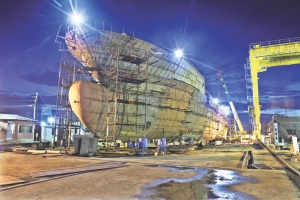 |
| |
Bangladesh is now considered a potential shipbuilding hub by foreign investors.
Photo: Din M Shibly |
Besides ready-made garments, Bangladesh has made significant progress in sophisticated industries like pharmaceuticals and heavy-industries like ship-building. In terms of production and export volume, these two sectors lag far behind frozen food, fertiliser, cement, ceramic, pottery and other traditional exportable items. Nevertheless, the technology and skill necessary for these two industries to meet global standards are noteworthy.
Before the promulgation of the Drug Control Ordinance 1982, the pharmaceutical sector was entirely dominated by multinational companies. Today about 250 pharmaceutical companies operate in the country; a majority of them are local, producing almost 97 per cent of the country's total requirement of medicine. As an LDC (Least developed country), patent rights are relaxed for Bangladesh, allowing the companies to duplicate and produce drugs at a lower cost. Thus, Bangladesh can offer essential medicine to a large number of people across the globe at lower prices. Hi-tech factory set-ups and the strict maintenance of quality have ensured export of medicine to more than 70 countries of the world including UK, Germany, Australia and the US. In fact, Bangladesh is the largest manufacturer of pharmaceuticals amongst the 45 LDCs.
Although crisscrossed by hundreds of rivers, Bangladesh's expertise at making oceangoing vessels could not have been predicted even in the 80s. Oddly enough, the country is now considered as a potential shipbuilding hub by foreign investors. The country has made the best use of its comparative advantage of cheap labour. We now export oceangoing vessels to countries like Denmark, Netherlands and Germany.
Another unlikely product for this agricultural goods producing nation is the manufacture and export of bicycles. As a light engineering product, Bangladeshi bicycles are attracting an increasing demand from European Union countries because of their price competitiveness. It is interesting to note that some of the leading companies of the world, including Raleigh, PCM and Motor and Sports of the UK and Aldi of Holland, Bachtenkirch Interbike of Germany, M&F De Scheemaeker and Formula Cycling of Belgium are importing bicycles from Bangladesh.
Besides these products, Bangladesh has also made a significant mark in the export of quality ceramic tableware and leather products. The country has almost reached self-sufficiency in ceramic toilet fittings, batteries and promising progress in capital intensive plants like cement, steel-rods and glass.
Education
Achieving Education Goals in Sight
| |
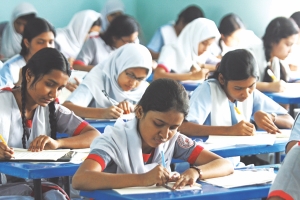 |
| |
The enrollment rate of girls in primary schools today now exceeds that of boys. Photo: Star File |
The education system in Bangladesh has been subject to many changes over the years as governments of different colour and hue have assumed power. During the colonial times, this country had a flawed education system in line with the exploitation, communalism and dependence on the colonial system. It, however, did not improve during the Pakistani regime, as a gulf of inequality existed between the then East and West Pakistan. This was thanks to the poor allocation of funds, non-fulfillment of the government's commitment to education, and the introduction of policies against the secular aspirations of the Bangladeshi people.
Post independence, under the Mujib government, primary education began to be considered a national responsibility. The first Constitution, introduced in 1972, specified that the State should adopt effective measures to establish uniform and universal mass education. It should do this by offering free and compulsory education to all children to such a stage as may be determined by law (Article 17, 1998:8-9).
Constructing primary education has been a priority agenda in Bangladesh since her independence. Subsequent governments have worked towards the diversified system of education that we see today. They have done this by trying to relate primary education to the needs of the society, with the aim to produce properly educated and trained citizens and ultimately eradicate illiteracy.
Numerous basic measures were taken by these governments to increase the literacy rate, enrollment into primary schools, completion of primary education, and ensure free education for all up to the secondary level. The measures also hoped to reduce the dropout rate as well as remove the gender disparity.
Increasing funds were allocated towards education in order to build more schools, purchase books, hire and train more teachers and mobilise NGOs and other private organisations to set up schools in rural areas. The National Education Policy that was established post independence now incorporates adult education. It recognises the importance of non-formal education that caters to the needs of those children who cannot be enrolled in school and those who are forced to drop out for various reasons, the primary one being poverty. Non-formal education not only empowers learners with literacy and communication skills, it also helps learners to address emotional and physical well-being, and provide basic technological and practical skills.
Bangladesh also fully complies with international obligations such as the Education For All (EFA) objectives, to which Bangladesh became a signatory in March 1990. Bangladesh also participated in the World Educational Forum (WEF) held in Senegal in April 2000, where 182 UNESCO member countries attended. The World Education Forum adopted six major goals, two of which became Millennium Development Goals later that year. The goals covered the attainment of Universal Primary Education (UPE) and gender equality, improving literacy and educational quality, and increasing life-skills and early childhood education programs. These were to be achieved within 15 years (EFA Global Monitoring Report, 2005:28).
The adult literacy rate of Bangladesh is currently 48.8 percent, according to a survey conducted by the Bangladesh Bureau of Statistics (BBS), a dramatic 7.3 percent increase from 2005. Out of this, 48.6 percent are male while 49.1 percent are female, which shows that Bangladesh has done a phenomenal job in tackling gender disparity in its primary education system. The youth literacy rate according to statistics collected by the World Bank is currently 75 percent. The primary school net enrollment/attendance between 2005 and 2009 has been 85 percent.
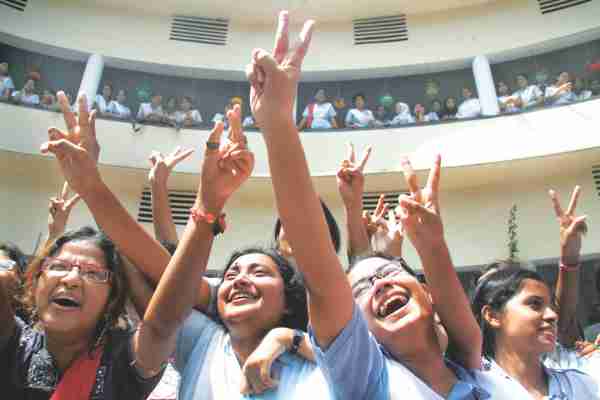
The adult literacy rate has seen a dramatic 7.3 percent increase. Photo: Star File
There are currently over 78,000 primary schools, over 13,500 secondary level schools, 35 public universities and 54 private universities in Bangladesh. There are both English as well as Bengali medium schools and universities. English medium schools are privately owned and modeled on the British education system. Currently, the education policy requires all English medium schools to be governed by one administration; however this stipulation is not being strictly followed by these institutions.
Although the overall education system has seen many improvements by governments over the last 40 years, there is much more that needs to be done in order to attain the goals set by the government, to reach 100 percent literacy and 100 percent enrollment by the year 2015. In order to achieve this, the government must work towards allocating more funds to the education sector, create a corruption free management system, encourage community participation to build better schools and increase NGO involvement to ensure non-formal education to those who need it.
According to experts, poverty in Bangladesh is the main reason for the increasing drop-out rates from primary education. Most people worry about feeding their families before sending them to school. The current and subsequent governments must also continue their efforts to eliminate poverty in order to bring improvements to the literacy rate.
Mobile Phone
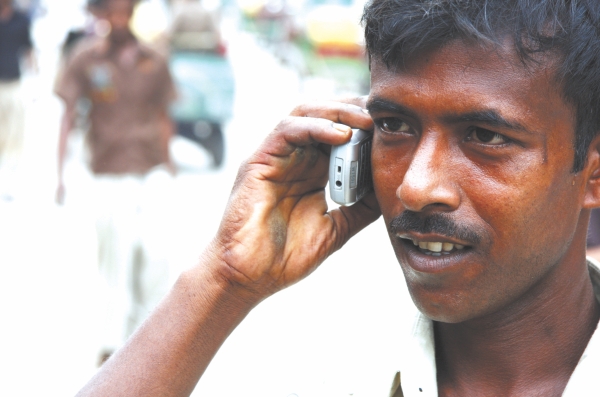
Photos: Zahedul I Khan
The Mobile Phenomenon
When the first mobile communications company of Bangladesh marketed its cellular phones in the late 90s in Dhaka, only a handful of people could afford the luxury of having one. The oversized handsets looked like some mysterious gadget from a Spielberg film. But now, nearly half of the country's population uses trendy and sleek mobile phones. To survive in the competitive market, the manufacturers and service providers have brought their prices and charges so close to the ground that even rickshaw pullers and labourers now use mobile phones.
To expand their reach to a larger number of people, some of the commercial banks have launched remittance services through mobile phones, a process that dramatically reduces the inconveniences of getting your desired bank service. Usage of internet through mobile phones is also phenomenal with young people. While the high-profit companies are making huge sums every year, they are also paying huge amounts to the government in taxes and other fees.
Asian University for Women
A College Without Limitations
| |
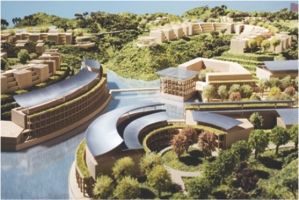 |
| |
Model of the Asian University for Women, Chittagoang. Image: Courtesy |
At a time when academia is becoming more hierarchical, exclusive and inaccessible, the newly established Asian University for Women offers an alternative educational paradigm that celebrates diversity, openness and interdisciplinary enquiry. Situated in the port city of Chittagong, AUW is world-class institution currently attended by women from all backgrounds, irrespective of race, religion or culture, from Afghanistan, Bangladesh,
Bhutan, Cambodia, China, India, Myanmar, Nepal, Pakistan, Palestine, Sri Lanka, and Vietnam. What is remarkable about this institution is that it prioritises underprivileged women, providing scholarships to students from poor, rural or refugee backgrounds.
It has a faculty that is as diverse as its student body, with teachers from all over the world. It may be international in its vision and scope, but “the University is rooted in the unique context of the region.” In many ways, AUW is a visionary institution that promotes cross-cultural understanding and cooperation, and promises women's emancipation from hegemonic structures (or social and political equality).
Civil Society
An Active and Relentless Civil Society
Bangladesh is home to one of the most thriving civil societies in the world. Bangladesh's civil society, which doesn't just comprise of NGOs, but also labour unions, citizen advocacy organisations and national and regional networks of activists, feminists, environmentalists etc., have contributed significantly to the social, political and economic progress of the country. They have been relentless in their resistance to human rights violations, corruption and anti-democratic practices. For over three decades, the civil society has put concerted pressures on the state and the private sector to maintain and advance the rule of law, curb corruptions and allocate more resources for creating opportunities for citizens, especially for the most disempowered segments of Bangladesh society. The civil society has been instrumental in lobbying for all progressive laws and amendments that have been promulgated in independent Bangladesh.
| |
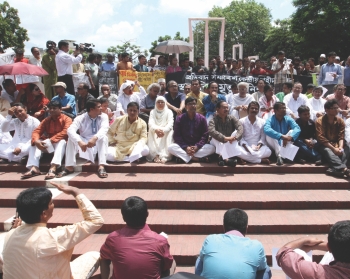 |
| |
Our vigilant civil society. Photo: Shawkat Jamil |
The women's movement in Bangladesh, in particular, has been very successful in bringing gender to the forefront of mainstream discourses. From low fertility rates to high enrollment rates, from greater participation in the workforce and decision-making positions to greater access to resources, the situation of women has improved dramatically in Bangladesh since independence. Much of the credit goes to the women's movement and the myriad of NGOs working on gender issues.
In addition, the country also has one of the largest NGO sectors in the world, with approximately 45,000 registered NGOs with the Ministry of Social Services, of which 2000 are active development NGOs. The Bangladeshi microcredit model is emulated all over the world now, and Mohammed Yunus, and the Grameen Bank, received the Nobel Prize in 2006 “for their efforts to create economic and social development from below.” BRAC, as of May 2010, is the largest NGO in the world, with branches in nine countries in Asia and Africa.
The proliferation of NGOs have been catalytic in spearheading poverty-alleviation efforts, and in providing safety nets and welfare benefits to the needy. NGOs have expanded the delivery of credit to the poor, developed a non-formal education programme for poor children, especially girls, and made health services accessible to remote villages all over the country. Moreover, some left-leaning NGOs have moved away from service delivery to pursuing consciousness-raising and mobilisation programmes to empower the marginalised masses to stand up against injustice.
Whatever the limitations of our civil society may be, it cannot be denied that without the individual and collective effort of a wide range of social and political actors, the contours of Bangladesh would look decidedly different.
Literature
A Tale of Two Languages
Akhteruzzaman Elias with his two magnum opuses–"Chilekothar Sepai" (The Soldier in an Attic) and "Khoabnama" (Tale of Dreams) – is the doyen of post-liberation Bengali literature. "The Solder in an Attic" depicts the mass upsurge of 1969 that threw Gen Ayub Khan out of power, setting the tone and tune of the people's movement in the near future. It was a time when the far Left was busy killing class enemies in the remote villages and was trying to replicate the classical Maoist formula of circling the towns with the villages. Little did they know that the tide of history was quickly turning in favour of the petit bourgeoisie, who, along with the lumpen elements of the society, were about to replace the quasi-feudal Punjabi ruling class to establish a new nationalist state.
The novel doesn't have one protagonist, it has many, and all of them represent either different classes or the ideas the society at that time was divided by. Osman is from the middle class and, as the storyline gets momentum, loses his sanity. Anwar, brought up in an upper class household, tries to declass himself and goes to his own village where a class war is going on in full swing. The war, or the battle to be precise, meets a miserable end. Haddi Khijir belongs to the lumpen proletariat who in the run up to the Liberation War was increasingly turning to the Left. But in the absence of a Marxist political force that could have read their pulse and led them to the revolution, Haddi's rebellion and angst went towards a different direction, the tide of history quickly engulfs his fury.
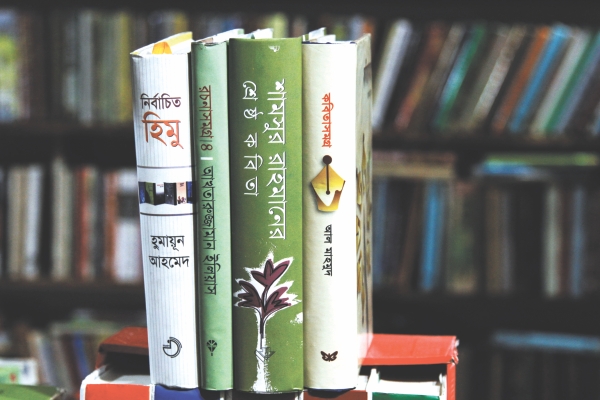
There has been a proliferation of Bangladeshis literature since independence. Photo: Amirul Rajiv
Elias, there is no doubt, is the master of Post-liberation Bengali literature. If you have any doubt, “Khoabnama”, his second and last novel, will dispel it. "The Soldier in an Attic" has social-realism with a tincture of existentialist crisis, and in "Tale of Dreams" Elias experiments with Magic-realism. Set in pre-partition Bengal, Elias, gifted with the language that he is, brings forth the oral history and the mythical nature of the people and the land that they inhibit.
Mahmudul Haque, who died in 2008, has been another canon among the post-liberation Bengali novelists. In "Onur Patshala", "Jibon Amar Bon" and "Kalo Borof", this reclusive writer deals with themes as diverse as middle-class life, existentialist crisis and men-women relationship. Shawkat Osman, Razia Khan, Selina Hossain, Ahmed Sofa, Syed Shamsul Haq, Anisul Haq and Nasrin Jahan and Shaheen Akhter along with other novelists, have made the Bengali literature proud.
In the world of Bengali poetry, Shamsur Rahman and Al Mahmud have towering presence. Rahman's world shifts from Existentialism to anti-autocracy movement, sometimes modernism even. Mahmud's oeuvre, on the other hand, is a curious one–it starts with a fiercely Marxist stance ("Shonali Kabin", where Marxism mingles with motifs of rural Bengal); Mahmud later relies heavily on religious metaphors, layer upon layer on which lies the soul of ancient Bengali culture. Other notable poets who have made their marks in the annals of post-liberation Bengali literature include: Rafique Azad, Shaheed Kadri, Nirmalandu Gun, Samudra Gupta, Abul Hasan and Sazzad Sharif. The world of Bengali short-stories is even more diverse. It has, among many others, writers as interesting as Hasan Azizul Huq, Showkat Ali, Shahidul Jahir, Ahmed Mostafa Kamal and Shushanta Majumdar.
Humayun Ahmed is the most popular Bangladeshi novelist. Interestingly enough, his first two novels "Nondito Noroke" and "Shankhanil Karagar" (The Conch-blue Prison) deal with lower-middle class life in the eyes of a social-realist. His novels, or novellas (for some are too short to be called novels), which later hit the bookstores took ordinary book-lovers by the storm. His Himu and Misir Ali series cater to a certain group of readers and are always in the best-seller list.
It is difficult to find an adult Bangladeshi who has never read or heard of Masud Rana. Rana, a spy working with the fictional Bangladesh Counter Intelligence, has assignments that take him to places as diverse and faraway as Tokyo and Tashkent. Rana's creator Qazi Anwar Hossain has introduced the culture of reading books to readers who would not have bought books had Masud Rana not come into being.
In Bangladesh, writing in English has long been confined to the post-colonial gentry who believed in an incorrigible sahib culture. First English novel written by a Bangladeshi in independent Bangladesh is "Seasonal Adjustment" (Commonwealth Writers' Prize Best First Book award, in 1995) by Adib Khan. Khan's protagonist, who has left Bangladesh for Australia immediately after Bangladesh's independence, briefly returns home, and sees the country of his birth in a new, changed light. His dislocation and the bond between him and his adolescent daughter make the novel an interesting read.
The second book in line came as long as 13 years later: Tahmima Anam's "A Golden Age" (Commonwealth Writers' Prize Best First Book award, in 2008) deals with individuals caught in the quagmire of history. In her first novel, young Tahmima does what her famous predecessors in Bengali novels has failed to do–she, with some remarkable brilliance, tells the story of men and women who are changed and morphed by the most important events of their lives–the independence war. Her second novel has come three years later: "The Good Muslim" has been shortlisted for the for the 2011 Man Asian Literary Prize.
The same year came out Ruby Zaman's "Invisible Lines". Born to a Bihari father and a Sylheti mother, her protagonist Zebunnessa Rahim makes difficult choices, and their unlikely outcomes in pre and post-independent Bangladesh make it a must read. Of the Bangladeshi English language poets, Kaiser Haq's latest book "Published in the Streets of Dhaka" (2007) has been received with critical acclaim.
Literature in both Bengali and English by Bangladeshis is thriving at an age when printed words are fighting a fierce battle with the television and the internet. In this part of the globe, books still have the upper hand, and rightly so for a nation that had laid down lives only to uphold its people's right to speak.
Progressive Laws
Paving a Progressive Pathway
| |
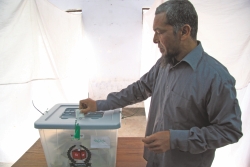 |
| |
Photo: Amirul Rajiv |
Bangladesh is a nation where the mindset of an overwhelming majority of the population is conservative, and religious beliefs and traditions play a major role in the political realm. Notwithstanding this, the governments, over the years, have established several progressive laws to serve the needs of an ever evolving, forward thinking society.
One such law is The Right to Information (RTI) Act 2009, a groundbreaking decision on the government's part, which gave all citizens access to information from public authorities as a right. The demand for RTI in Bangladesh was not made at the grass root level, as it was in India. It was rather made by the civil society. They realised that this act would give Bangladesh a chance to improve its governance, curb corruption and establish accountability and transparency in public institutions.
The RTI makes it mandatory for all authorities concerned to cooperate with and provide information to any citizen who requests for it. Documents such as rules, regulations, laws, manuals and information related to permit, license, grant allocation etc are listed under the category of information.
In recent times, the use of the Internet in many households, schools and workplaces has made a pathway for a new dimension of crime. Internet pornography, stalking and harassment, religious and social corruption, privacy violation and copyright infringement are among some considered to be cyber crimes. To curb these, the government has been very proactive in developing policies and acts to safeguard our activity online. The National ICT Policy, Cyber Law, Information Technology (Electronic Transactions) Act (ITETA) 2000 and the more recent Information and Communication Technology Act (ICTA) 2006 not only facilitate electronic commerce, the expansion and development of information technology, they also bring cyber criminals to justice, issuing a maximum of 10 years sentence in prison and fines up to Tk 10 million for some of the above mentioned offenses.
Ratifying The Citizens (Amendment) Act 2009 was another bold step taken by the government, which removes gender discrimination present in The Citizenship Act, 1951. The previous act, while granting citizenship to children with Bangladeshi fathers and foreign mothers, refused to do the same for children with Bangladeshi mothers and foreign fathers. As growing numbers of Bangladeshi women are now marrying foreigners, the government decided to amend this act and grant citizenship to their children.

Voting rights include minority groups such as transgendered population and stranded Pakistanis.
Photo: Amirul Rajiv
A number of recently established decrees show the government's efforts to amend certain Acts and Ordinances in order to restore women's rights and their social status. Among the most noteworthy is the Dowry Prevention Act of 1980, which forbids all citizens from giving or receiving dowry. Nari-o-Shishu Nirjatan Daman Ain 2000, prohibits all acts of violence against women and children. The Women's Act 2000 is one that, for the first time, has expanded the definition of rape to a great extent but has failed to incorporate marital rape. It has also for the first time, made sexual assault and harassment punishable offenses. As of 2010, mobile courts have also been given the power to prosecute stalking and sexual harassment, although to what extent these laws are being implemented is yet to be seen.
Another progressive stance taken by the Bangladeshi government has been the reconstitution of the National Human Rights Commission in 2009, a national advocacy institution for the promotion and protection of human rights in a broader sense, which includes safeguarding the dignity, worth, and freedom of every human being.
The government is also currently taking the enactment of the Mental Health Act under consideration. For decades, the government failed to amend the Lunacy Act of 1912, established during colonial times, which has been repealed by India and Pakistan. This Act discriminates against, and strips all mentally impaired individuals of their rights and dignity. Mental illness is not included in the overall Health Care Policy of Bangladesh as it is in most countries all over the world. In 2009, a Mental Health Act was proposed by several civil society groups and a request made to repeal the Lunacy Act, which the government has agreed to take into consideration.
The government also took a liberal stance in 2008, when it allowed about a 100,000 hijras (transgendered population) to vote in the Bangladeshi elections for the first time. Hijras are ostracised from the Bangladeshi society and lead impoverished lives and are often exposed to the dangers of sexual and physical abuse.
Another group that has received acceptance by the government is the “stranded Pakistanis” better known as Biharis, left behind after the Liberation War. On May 19, 2008, the Dhaka High court granted citizenship to about 150,000 of these refugees who were minors at the time of the Liberation War and those who were born post liberation were also given the right to vote.
The governments have not only created new and more progressive laws, they have also made amendments to the existing ones. The 15th amendment to the constitution passed on 30 June 2011, restores Secularism and freedom of religion in Bangladesh. This amendment also includes strict provisions against military takeovers and treats them as treachery and subversive acts. The Parliament has been given the power to issue maximum penalty to those trying to seize state power.
While the Bangladeshi governments have shown aptitude for liberal and forward thinking and have made several significant changes and additions to the existing laws, a greater effort needs to be made to execute these and to make way for new ones. To accomplish this, the government must raise awareness, encourage acceptance and equity and work towards reducing corruption in all levels within the government and the legal system of this country, so that we may finally be able to call ourselves a progressive nation.